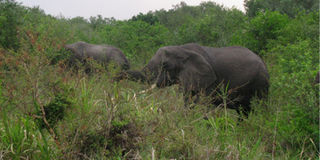Tighten restrictions on import, export and sale of ivory products

The Wildlife Conservation Society (WCS), in conjunction with Uganda Wildlife Authority (UWA) in 2015 conducted an aerial survey of elephants in Uganda’s national parks. The result of the survey projected that elephant numbers are increasing, and stood at 5,000.
This news is not good enough for conservationists and Uganda as a country. We need to invest more effort to ensure that the number of Uganda’s elephants increases more than what the survey has projected. The survey confirmed the need to establish trans-boundary conservation programmes with South Sudan and Kenya and to strengthen existing collaboration with the Democratic Republic of Congo.
It should be noted that the rate at which poachers are killing elephants in our national parks is highly alarming. All stakeholders in this regard, should wake up and start conducting massive sensitisation countrywide if we are to conserve and even increase the number of our elephants.
In the 1970s and 1980s, because of the widespread poaching and limited resources for national parks, Uganda’s elephant numbers plummeted. Elephants became confined to protected areas due to poaching pressures and numbers dropped as low as 700-800.
Statistics however show that we have improved in our protection and conservation mechanisms. Since the 1990s and the creation of UWA, together with support from the government, donors, and conservation partners such as the Natural Resource Conservation Network (NRCN), elephant numbers are now on the increase. But even then, a lot needs to be done by completely stopping the illegal wildlife trade.
Despite the rampant poaching and ivory trafficking across much of Africa, it is very encouraging to see elephant numbers increasing in Uganda as a result of effective protection in our parks. And for this, we credit all the stakeholders for a job well done.
Aerial surveys conducted in June 2014 by WCS and UWA staff estimated 1,330 elephants in Murchison Falls National Park, 2,913 in Queen Elizabeth National Park and 656 in the Kidepo Valley National Park and Karenga Community Wildlife Management area.
Elephant numbers in Queen Elizabeth Park have reached levels similar to those in the 1960s before heavy poaching hit the park. There is a continued population recovery in Murchison, a former elephant stronghold, and UWA’s protection efforts are yielding positive results for many wildlife species in Kidepo Valley and Karenga.
NRCN, which plays the role of a conservationist is keeping a keen eye on those poachers and with strong collaboration with the police and the Judiciary, suspects are being arrested and brought to book. As a result, those who plan to engage in illegal wildlife trade mostly in ivory are deterred from carrying out their plans.
In 2012, Uganda was labelled by CITES (Convention on International Trade in Endangered Species) as one of the eight countries of primary concern in the ivory trade because of the volume of illegal ivory that had passed through the country. Here, we have a big task to have our country struck off from that list.
While it is encouraging that elephant numbers are increasing, this is not enough because poaching remains a big challenge in Uganda and there is need to remain vigilant. Recently, NRCN and police have been arresting suspects with ivory. This means Uganda is not completely secure from poaching. However, the new survey results provide encouragement for conservationists when nearly every other country in Africa is showing drastic decline in numbers of elephants.
The government should come up with strict penalties for those caught in the act of illegal wildlife trade in the country so that we can protect and conserve wildlife.
Law enforcers also need to do robust work. For example, the Uganda Wildlife Act Section 30, prohibits the utilisation of wildlife without a wildlife use right. It further states that “No person may engage in any of the activities under Section 29 or any other activities of the nature which involve the utilisation of wildlife and wildlife products without first obtaining a grant of a wildlife use right.”
Some countries are rich because they use our raw materials and worse still, they have the money and with the biting poverty in Africa, we are pushed to trade in illegal wildlife, not knowing that we are depleting our natural resources.
In African forests, mostly in DR Congo, which has its forest belt extending to Uganda’s border in the west, elephants declined by 62 per cent in less than a decade. This drastic decline was due to a lethal cocktail of illegal hunting, habitat loss and civil strife that have impeded our region.
Uganda should tighten restrictions on the import, export and sale of ivory products to, from and in the United States, China and any other country. Let us handle the crisis of the animal slaughter preserve our wildlife.
Mr Odeke is the head of media relations with Natural Resource Conservation Network. [email protected]




